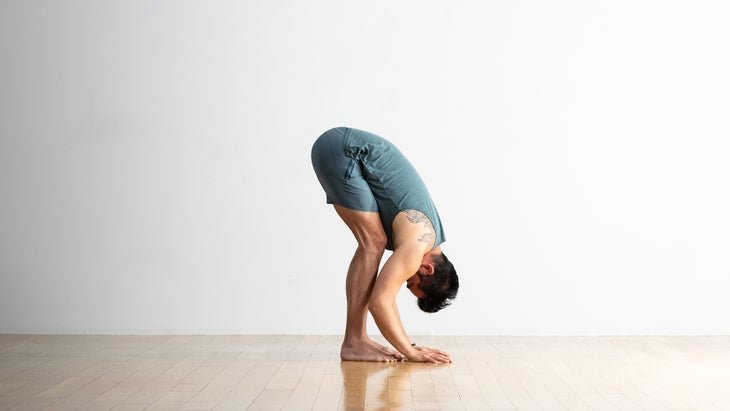“], “filter”: { “nextExceptions”: “img, blockquote, div”, “nextContainsExceptions”: “img, blockquote, a.btn, a.o-button”} }”>
It’s late. You’re tired but tense. You’re trying to settle down but instead you simply toss and turn. You start to boredom scroll but that wakes you even more. And after an hour or so of frustration you’re no longer in any sort of mood to rest. If some version of this scenario loops for you most nights, the solution you’ve been needing may be practicing yoga for sleep.
In the last several years, a number of research studies indicate that practicing yoga for sleep can reduce the time it takes to fall asleep as well as enhance the quality of your sleep. What you won’t find in their conclusions is the added benefit that it takes only a few minutes to try, has no scary side effects, won’t make you groggy the next morning, and beats scrolling.
How Does Yoga for Sleep Work?
Practicing yoga for sleep relies on an uncomplicated equation of stretching and breathing that enables the physical and psychological release that you need. It isn’t limited to a specific style or sequence of poses. What makes a pose conducive to sleep is as much about the manner in which you practice it as its actual shape. Rather than race through a series of poses or push yourself to take the most intense version of poses, simply hang out as you let yourself feel a sustained stretch. Notice if you’re holding your breath. Settle into a slow and steady breathing pattern. Take your time in between the poses and move at a measured pace.
Essentially, practicing yoga can help you access a less fitful state of rest. And if your mind defaults into worrying, which it will, quietly bring your attention back to something in your physical awareness—the feeling of the blanket against your skin, the subtle current from the vent or fan, the release of tension in your face that you weren’t even aware that you were holding. Let yourself focus on the immediacy of your actual situation rather than the imagined scenario in your thoughts.
15 Ways to Practice Yoga for Sleep
You can practice the following poses one after another, which adds up to 30 minutes, or you can sample any that seem compelling to you. But don’t skimp on your final resting pose. Whether that’s Savasana or Legs Up the Wall, that’s your true precursor to sleep.
Many of the poses can be practiced in bed.
Props
Blocks or stacks of books; a blanket or two; and bolster or a couple of stacked bed pillows
Breath
Lengthen your breath and let it be relaxed rather than forced
1. Standing Forward Bend (Uttanasana) | 1 minute
Come to a Standing Forward Bend with your feet hip-width apart or a little wider, especially if you experience low-back discomfort. Bring a slight bend to your knees and release your shoulders. You can let your hands rest alongside your feet or loosely hold opposite elbows, keeping a relaxed grip.
Exhale and lengthen through your back, allowing your neck and shoulders to relax and your head to lower toward the mat. You can want to slowly turn your head one way and then the other or slowly sway your upper body from side to side. Continue to release the tension in your forehead, jaw, shoulders, arms, and chest as you dangle. Breathe here for 1 minute. Press down through your feet, inhale, and slowly rise to standing.
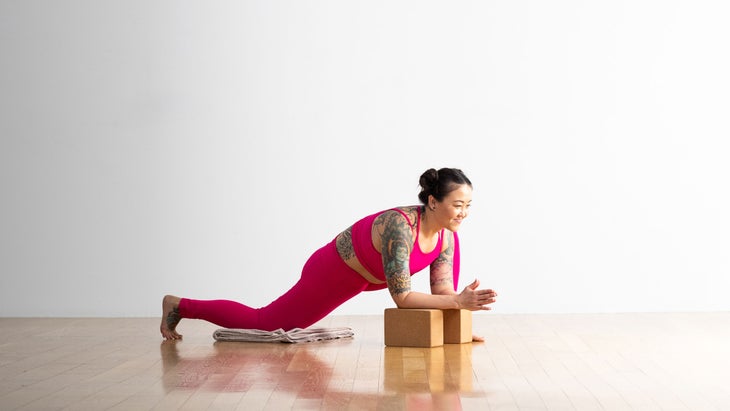
2. Lizard Pose (Utthan Pristhasana) | 2 minutes
From hands and knees, bring your left foot forward between your hands and lower your right knee to the floor in a Low Lunge. Inch your left foot further to the left and bring your hands or forearms to the floor, bed, or blocks underneath your shoulders in Lizard Pose. You want to feel a stretch along the front hip of your back leg. You can keep your back toes tucked or not.
Take your gaze slightly forward and down. Rather than hold yourself in the pose, try to let your weight settle and any tension in the shoulders release. Breathe here for 1 minute. Switch sides.
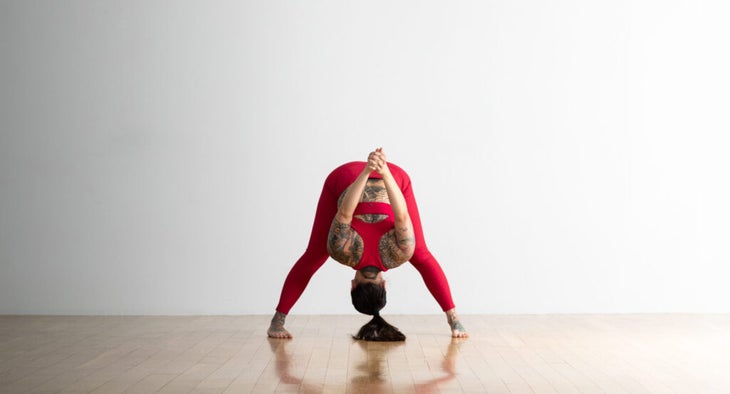
3. Wide-Legged Standing Forward Bend (Prasarita Padottanasana) | 1 minute
Step your feet wide apart and angle your toes slightly inward. Inhale and stand tall as you lift your chest. Exhale and slowly bend forward from your hips, resting your fingertips on the floor or blocks in Wide-Legged Standing Forward Bend. Bend your knees a little or a lot. Let your neck relax and your head hang heavy.
To stretch your shoulders, interlace your fingers behind your back or take reverse prayer hands behind your back. To stay more relaxed, rest the top of your head on a block, a stack of books, or a couple of pillows to help relax your neck and shoulders and release tension. Take a long slow breath out here. Stay here for 1 minute. With each breath out, rest your awareness on a place in your body where you feel tension and try to release it. To come out of the pose, press down through your feet, bend your knees, and inhale as you slowly rise to standing.
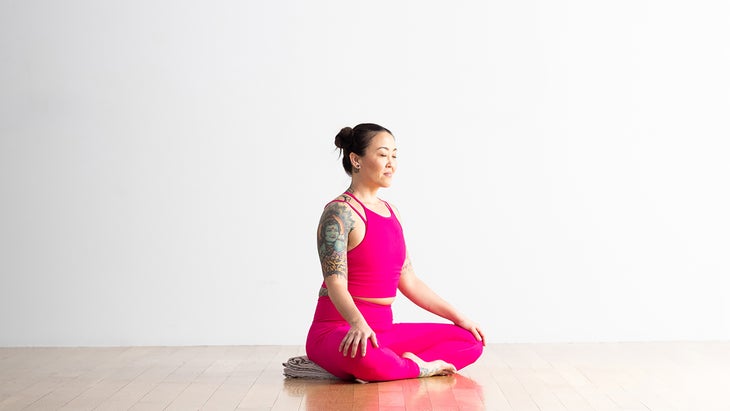
4. Easy Pose (Sukhasana) | 3 minutes
Sit on the edge of a folded blanket or a couple of pillows with your legs crossed and your shoulders stacked over your hips in Easy Pose. Close your eyes and tune into the rhythm of your breath. Rest your hands on your knees or in your lap. Become aware of your heartbeat. Inhale as you sit a little taller. Exhale as you feel yourself settle down through your sit bones. Simply breathe here for 3 minutes.

5. Child’s Pose (Balasana) | 1 minute
Come onto your hands and knees and inch your knees wider than your hips and bring your big toes to touch behind you. Sink your hips toward your heels and lower your chest as you rest your forehead on the floor, bed, or pillows in Child’s Pose. You can extend your arms alongside your head for more of a shoulder stretch, although it’s less effort to rest them alongside your legs, palms facing the ceiling. Take a long, slow breath out here.
Let the weight of your body sink into the floor or bed beneath you. Breathe in as if you want to draw the breath into your belly and then exhale and feel the tension release from your body. Settle into a slow and steady breath pattern and linger here for at least 1 minute.
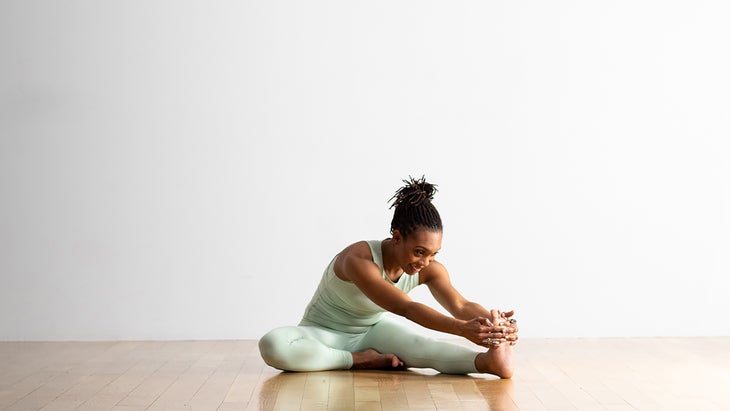
6. Head to Knee Pose (Janu Sirsasana) | 2 minutes
Come to a seat on your mat with your legs extended straight in front of you. Bend your right knee and bring the bottom of your foot against your inner left thigh. Inhale and sit slightly taller. Exhale and start to lean forward at your hips over your straight leg in Janu Sirsasana.
Try to let your role in the stretch be as passive as possible. You can rest your hands on your foot or shin but don’t grip. Maybe you take a block or pillows beneath your forehead as support. Let your shoulders fall away from your ears. Remain here for at least 1 minute. Switch sides.
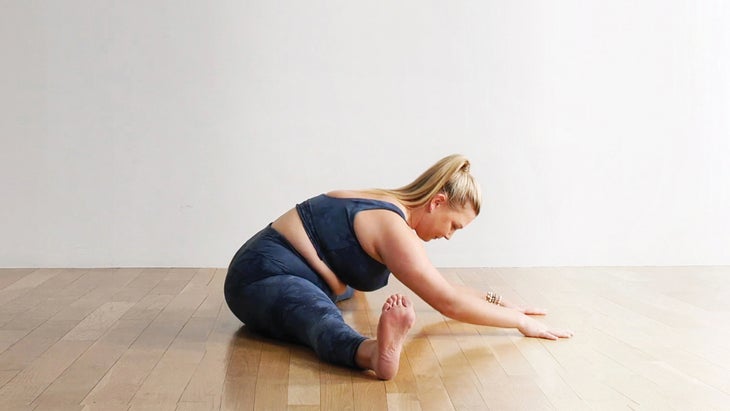
7. Seated Wide Angle Pose | 2 minutes
Slowly come to a seated position with your legs apart from one another. Inhale and lengthen your spine. Exhale as you lean forward, a little or a lot, and walk your hands toward the wall in front of you. Keep your back flat at first and stay there or let your upper back round.
Notice if you’re holding your breath. Slowly exhale and notice where you’re still hanging onto tension. Breathe here for 1 minute. If you like you can turn this into a twist by coming upright and then gently twisting your chest toward your right leg, resting your fingertips or hands on the floor or bed, and leaning forward toward that leg. Breathe here for 1 minute. Inhale and slowly lift your chest. Repeat on the other side.
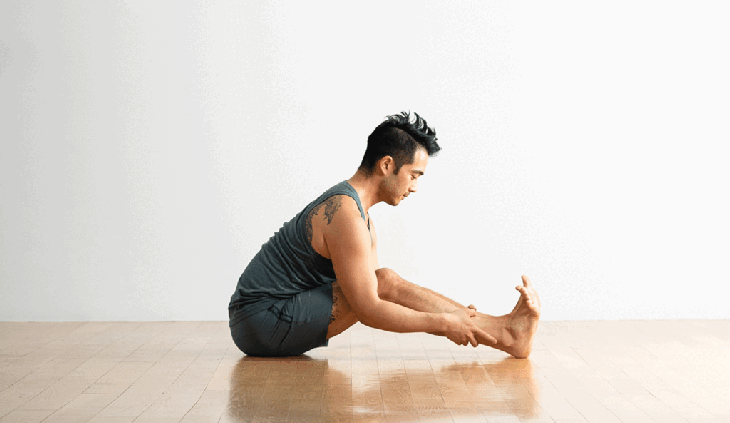
8. Seated Forward Bend (Paschimottanasana) | 1 minute
Sit on the edge of a folded blanket or a pillow with your legs extended straight in front of you. If you feel strain along the backs of your legs, roll a blanket and slide it underneath your knees. Bring your feet together or take them hip-distance apart. Slowly inhale and sit tall. Exhale as you lean forward with a flat back in a Seated Forward Bend.
Stay here or let your back round as you release your shoulders and neck. You can rest your forehead on a block or stacked pillows if that’s more comfortable. Breathe here for at least 1 minute.
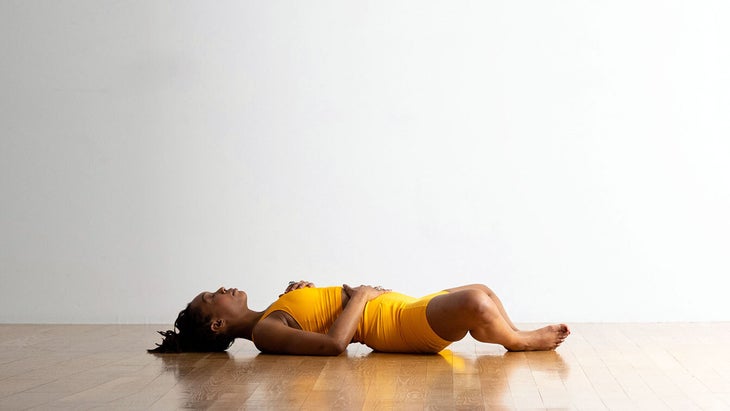
9. Reclining Bound Angle Pose (Supta Baddha Konasana) | 2 minutes
Sit and bend your knees with your feet on the floor or bed. Lean back, first on your forearms and then all the way down. Bring the bottoms of your feet together and let your knees fall apart. If you like, slide a pillow or two beneath each knee to help your lower body relax.
Relax your legs, shoulders, and neck. Remain here for at least 2 minutes. Simply breathe. Using your hands, bring your knees together and then slowly roll onto one side.
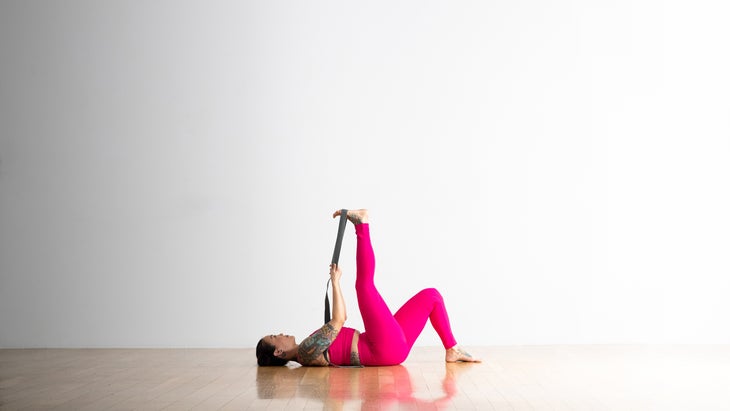
10. Supta Padangusthasana (Reclining Hand-to-Big Toe Pose) | 2 minutes
Lie on your back with your knees drawn into your chest. Bend your left knee and place your left foot on the floor or bed. Inhale and straighten your right leg toward the ceiling. Clasp the back of your thigh with your hands or use a strap, towel, or sweatshirt looped around your thigh or the arch of your foot and hold it with both hands in Reclining Hand-to-Big-Toe Pose. Push your foot against the strap or your thigh against your hands until you feel a stretch but not a strain. Remain here for about 1 minute. Switch sides.
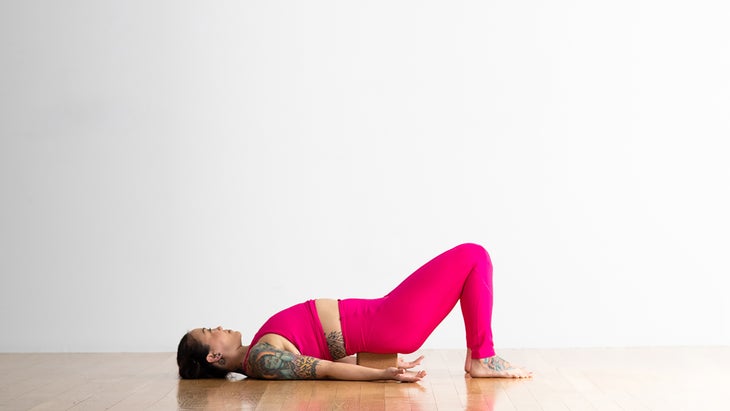
11. Setu Bandha Sarvangasana (Bridge Pose) | 1 minute
Come onto your back. Bend your knees and place your feet hip-distance apart beneath your knees. Inhale, lift your hips, and place a block or a couple of firm pillows under your sacrum (the flat, triangle-shape bone in your lower back). Release your weight onto the support in Bridge Pose. It should feel comfortable and supportive. If it does not, lift your hips off the block and readjust it.
Relax your arms alongside your body, palms facing upward, or take them in a cactus shape. Remain here for at least 1 minute. Inhale and lift your hips enough so that you can easily slide the block off to the side. Slowly lower yourself and allow your low back to sink to the mat. Pause here.
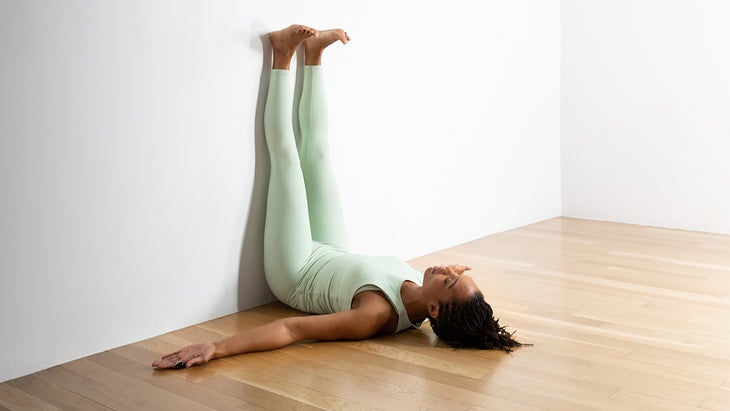
12. Legs Up the Wall (Viparita Karani) | 3 minutes
Sit alongside a wall with one hip touching it and bring your hands slightly behind your hips. Bend your elbows and slowly come onto your back as you simultaneously swing your legs up the wall. Bring your legs hip-distance apart and let them rest against the wall, keeping a slight bend in your knees if that’s more comfortable. Rest in Legs Up the Wall with your arms by your sides or in cactus arms with your palms facing upward.
Let the weight of your body sink into the floor. If this isn’t comfortable for your lower back, try Legs up the Ottoman or Legs up the Bed by bending your knees and resting your calves on the support. Remain here for at least 3 minutes. You may find yourself falling asleep in this classic yoga for sleep position, which you can also practice in bed if you don’t have a headboard.
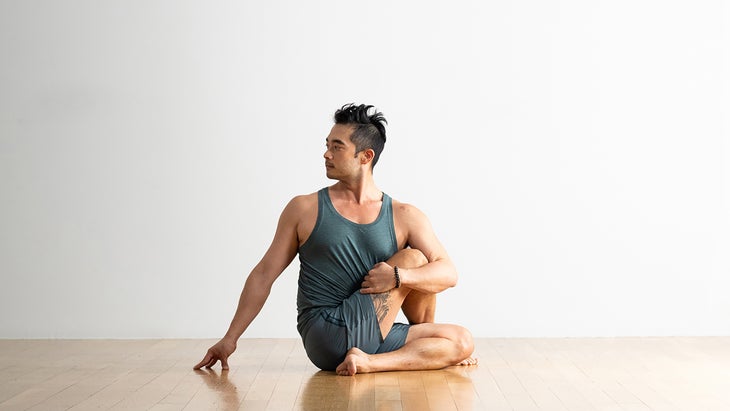
13. Half Lord of the Fishes Pose (Ardha Matsyendrasana) | 2 minutes
Come to a sitting position and cross your ankles. Inhale as you lift your spine. Exhale as you twist a little and place your right hand behind your right hip like a kickstand. Keep your left leg straight in front of you or bend your knee and bring your left heel toward your right hip. Inhale and lengthen through your spine. Exhale and rest your left hand on your outer right thigh in Half Lord of the Fishes. (If this feels too constrictive, simply sit with your ankles crossed in front of you and then twist to the right.
Relax your shoulders. Unclench your jaw. Notice if you start to hold your breath and release it. Stay here for at least 1 minute while you let your breath be slow and easy. Release and come back to center. Pause here before repeating on the other side.
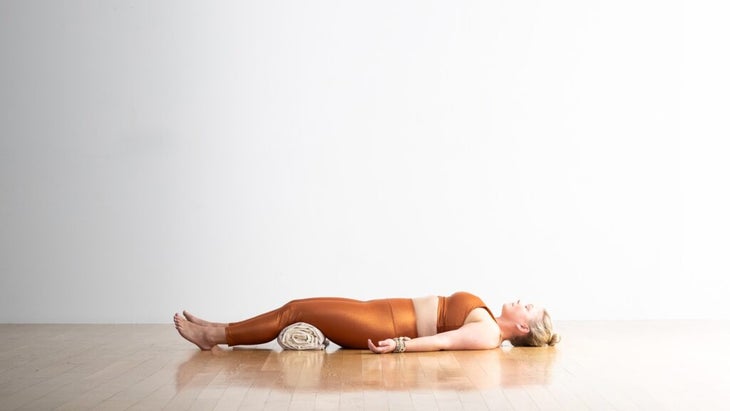
15. Corpse Pose (Savasana) | 4 minutes
Lie on your back with your legs relaxing at least hip-distance apart and arms resting at your sides, palms up. If you prefer, slide a bolster or a couple pillows beneath your knees to help relieve tension in your low back. Let the weight of your body sink into your mat and allow your attention to rest on your breath. Take a long, slow exhalation. Stay here for at least 4 minutes although you can linger here as long as you like. You may prefer to take Savasana in bed where you’re more likely to experience, quite literally, yoga for sleep.

